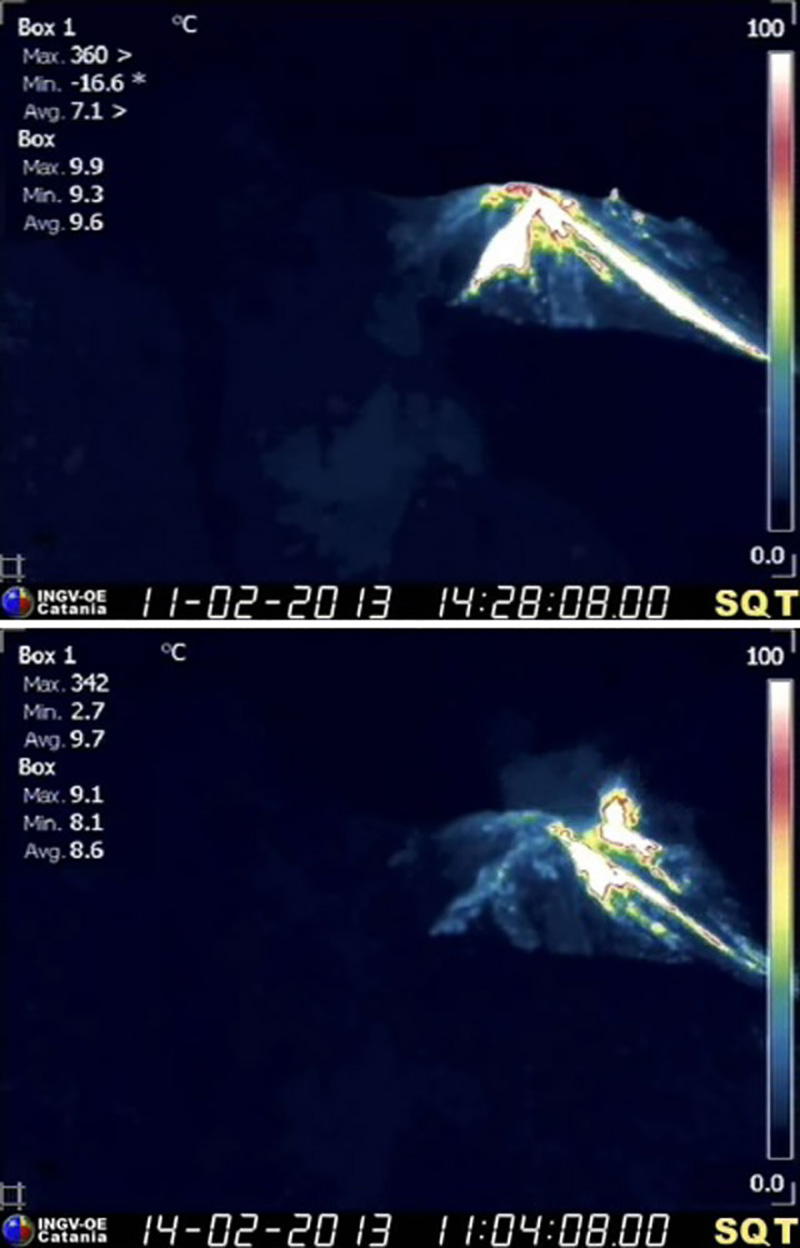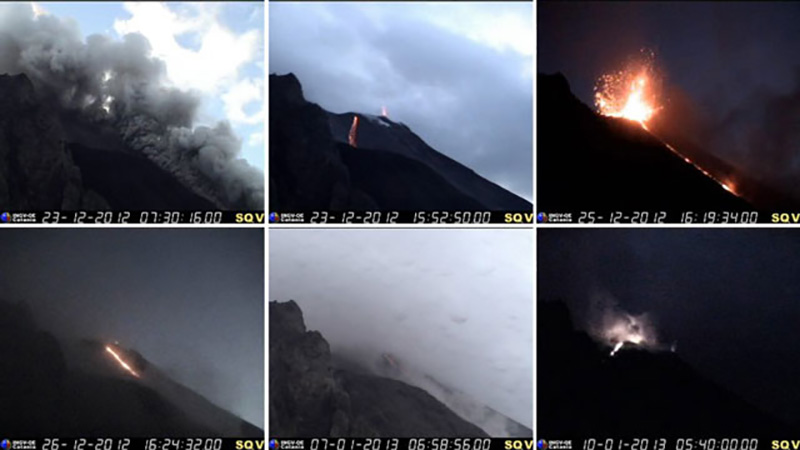Report on Stromboli (Italy) — December 2013
Bulletin of the Global Volcanism Network, vol. 38, no. 12 (December 2013)
Managing Editor: Richard Wunderman.
Stromboli (Italy) Small-to-moderate eruptions continue through February 2013
Please cite this report as:
Global Volcanism Program, 2013. Report on Stromboli (Italy) (Wunderman, R., ed.). Bulletin of the Global Volcanism Network, 38:12. Smithsonian Institution. https://doi.org/10.5479/si.GVP.BGVN201312-211040
Stromboli
Italy
38.789°N, 15.213°E; summit elev. 924 m
All times are local (unless otherwise noted)
Our last report, (BGVN 36:09), covered activity at Stromboli through 11 October 2011, characterized by explosions, spattering, rockslides, and occasional lava flows. Similar activity persisted through February 2013. Stromboli (volcano and island) sits N of Sicily in the Tyrrhenian sea along the N side of the Aeolian archipelago.
Activity during 2011. The activity documented in October 2011 continued into November, December, and January 2012, and was concentrated at the two active vent areas in the northern and southern portions of the crater terrace. The wide array of activity noted above fluctuated. There were, along with frequent episodes of spattering, in particular on 10 December 2011. The spattering episodes occurred in the southern area and did not lead to the formation of any lava flows.
Activity during 2012. Stromboli exhibited two periods of isolated activity early in 2012, discussed next. On 16 February there were two sequences of up to 6 explosion earthquakes of medium-high amplitude, and ~9 Very Long Period (VLP) events per hour.
On 6 March, instruments detected both tremor coupled with a strong explosion and at least three major explosions. The first event, at 0643 UTC, presented a VLP component with amplitude ~10-times higher than the daily average. The last event, at 0645, was also of very high amplitude. The VLP events occurred at a rate of ~12 per hour, at a low level with a single event of high amplitude, corresponding to the first event in the sequence at 0643. The VLP sequence was followed by an increase in tremor lasting ~30 minutes. The tremor amplitude was medium-low with its peak corresponding to the earlier events seen around 0643.
On 22 November 2012, the persistent explosive activity at Stromboli showed a clear increase, with episodes of spattering and low lava fountains from two vents in the northern and central portions of the crater terrace.
Beginning on 23 December 2012, repeated lava overflows from the crater terrace generated small lava flows down the northern and northwestern sectors of the Sciara del Fuoco (see images below), and were accompanied by numerous landslides.
Major lava flows occurred on the evening of 23 December 2012 (to the N), during 25-27 December 2012 (to the NW), and on the morning of 7 January 2013 (to the NW). Lava vented from points just below the rim of the northernmost explosive vent on the crater terrace. During the intervals between the main effusive episodes, lava vented at extremely low, releasing numerous incandescent blocks down the Sciara del Fuoco (the area within the sector collapse). At times, small lava flows advanced for a few tens of meters before disintegrating into blocks, such as on the morning of 10 January 2013 (see the last photo in the sequence below in figure 82).
Around this time, in all cases, the effusion of lava was preceded, and often accompanied, by intense explosive activity on the crater terrace.
More insight into behavior at Stromboli during this December 2012-March 2013 eruptive phase can be found in Di Traglia and others (2014). They applied the ground-based InSAR monitoring system at Stromboli volcano, linking changes in displacement and other field-monitored observations to volcanism.
Activity during January-February 2013. A new phase of intermittent effusive activity at Stromboli consisting of small overflows of lava from the crater terrace began on 8 February 2013 and continued with significant fluctuations until the morning of 17 February. During this interval, several episodes of effusive activity occurred, which produced lava flows reaching several tens to a few hundred meters in length in the northern and northwestern sectors of the Sciara del Fuoco.
Spattering from vent N2, which lies at the top of a hornito perched on the NW rim of the crater terrace, continued for a few hours, and then diminished during the late afternoon of 14 February. See Figure 83. Subsequently, effusive activity diminished considerably, producing only very small lava overflows that extended a few tens of meters downslope to the NW. On the morning of 17 February, all effusive activity ceased and mild Strombolian activity resumed.
 |
Figure 83. Frames extracted from video recorded by the thermal monitoring camera at 400 m elevation on Stromboli (SQT), showing effusive activity on 11 February (top) and 14 February 2013 (bottom). |
After an interval of 10 days of normal Strombolian activity, Stromboli again produced small lava overflows from the crater terrace from the afternoon of 27 February 2013 through the following night. A second episode of lava overflow started on the evening of 1 March and ceased the next afternoon. Both overflows were fed by continuous spattering from vent N2.
Reference. Di Traglia, F., Intrieri, E., Nolesini, T., Bardi, F., Del Ventisette, C., Ferrigno, F., Frangioni, S., Frodella, W., Gigli, G., Lotti, A., Tacconi Stefanelli, C., Tanteri, L., Leva, D., Casagli, N., 2014, The ground-based InSAR monitoring system at Stromboli volcano: linking changes in displacement rate and intensity of persistent volcanic activity, Bulletin of Volcanology 76:786DOI 10.1007/s00445-013-0786-2.
Geological Summary. Spectacular incandescent nighttime explosions at Stromboli have long attracted visitors to the "Lighthouse of the Mediterranean" in the NE Aeolian Islands. This volcano has lent its name to the frequent mild explosive activity that has characterized its eruptions throughout much of historical time. The small island is the emergent summit of a volcano that grew in two main eruptive cycles, the last of which formed the western portion of the island. The Neostromboli eruptive period took place between about 13,000 and 5,000 years ago. The active summit vents are located at the head of the Sciara del Fuoco, a prominent scarp that formed about 5,000 years ago due to a series of slope failures which extends to below sea level. The modern volcano has been constructed within this scarp, which funnels pyroclastic ejecta and lava flows to the NW. Essentially continuous mild Strombolian explosions, sometimes accompanied by lava flows, have been recorded for more than a millennium.
Information Contacts: Boris Behncke and Mauro Coltelli, Istituto Nazionale di Geofisica e Vulcanologia (INGV) Osservatorio Etneo (Catania), 95125 Catania (URL: http://www.ct.ingv.it/).


